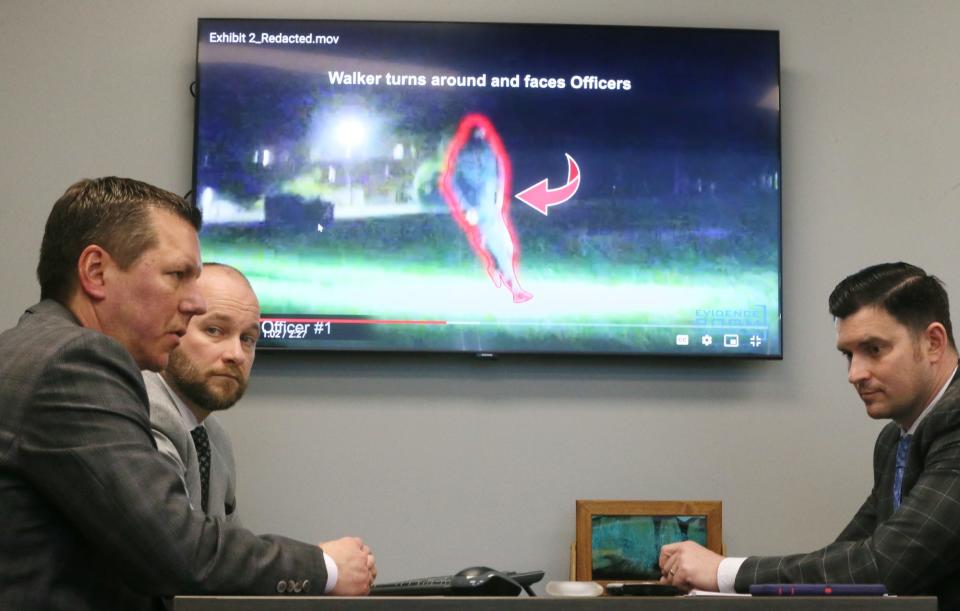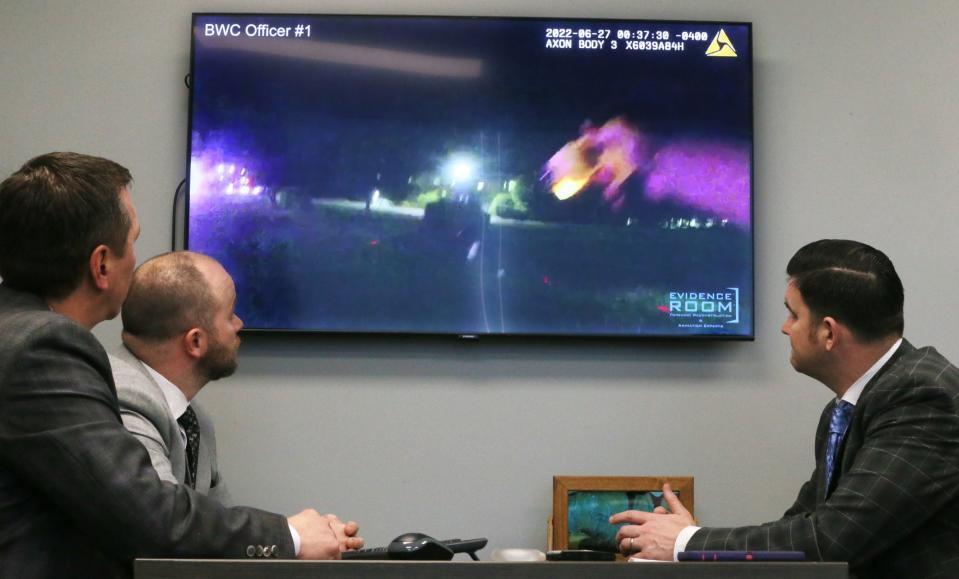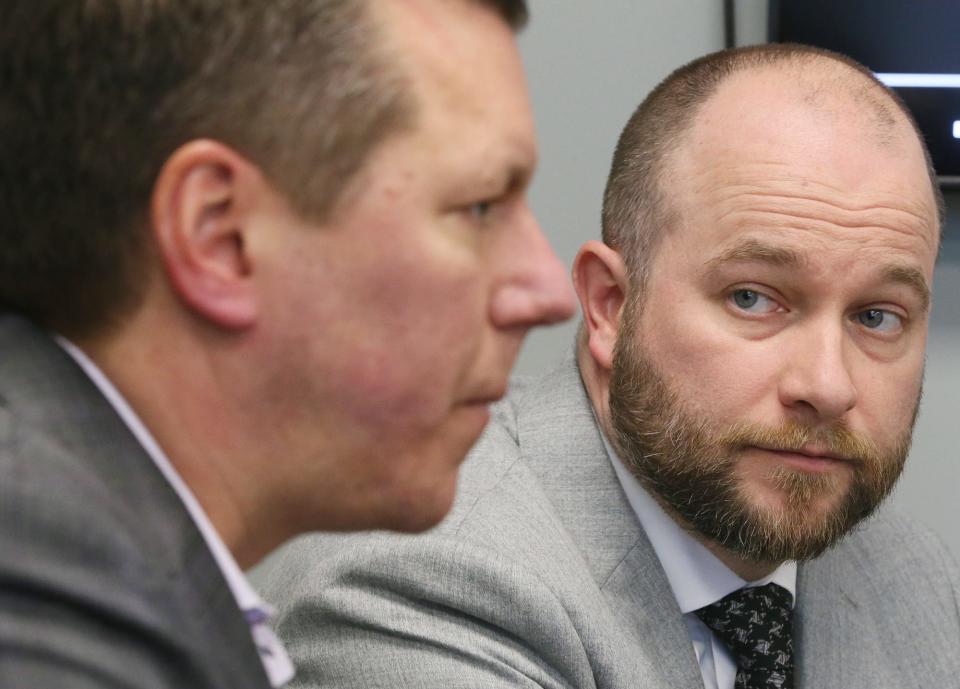Videos show what led to Jayland Walker's shooting from Akron officers' perspective
Akron officers following Jayland Walker onto state Route 8 told dispatchers that Walker fired a shot, resulting in a “Signal 21” that alerted all police in the city.
Officers chasing Walker on foot after he fled from his car deployed Tasers at Walker three times, with the stun-gun shots either not connecting or having no impact.
As Walker fled, he reached toward the pockets of his hoodie and waistband and raised his arm, leading officers to think he might be reaching for or drawing his gun.
These are among the highlights of videos created at the request of attorneys representing the Akron officers who killed Walker to show what happened leading up to the June 27 shooting from the perspective of the eight who shot him more than 40 times.

The officers’ attorneys also hired a use-of-force expert and gave his report, along with the videos, to the assistant attorneys general who presented evidence to a special grand jury that considered Walker’s shooting. It was up to the assistant attorneys general to decide what evidence to present to the grand jury, which returned a no-bill Monday, meaning the officers won’t face criminal charges.
“We felt our role was to provide as much information as we could to the decision-makers,” said Don Malarcik, whose law firm is representing three of the eight officers involved in Walker’s shooting.
The attorneys didn’t publicly release this information while the grand jury was still meeting. Malarcik said they didn’t want to be seen as trying to taint the grand jury process.
Grand jury decision: No criminal charges for 8 Akron officers who shot Jayland Walker
Walker’s shooting was investigated by the Ohio Bureau of Criminal Investigation (BCI), at the request of the Akron police chief. The Ohio Attorney General’s Office then presented the result of the investigation to the grand jury, which convened April 10 in Summit County Common Pleas Court.
The grand jury met until Monday afternoon, with Attorney General Dave Yost announcing the jury’s decision that the officers' actions were reasonable in a virtual press conference at 3:30 p.m.
Videos show what led up to Walker's shooting
The three videos of the Walker incident were created by Scott Roder, founder of the Evidence Room, a California company with an office in Cleveland that specializes in forensic reconstruction videos.
The company has been part of more than 1,000 jury trial consultations that involved homicides, officer-involved shootings, pursuits and suicide investigations in the past 20 years.

For the videos on the Walker shooting, the attorneys provided Roder with the officers’ body-worn camera footage and copies of videos of the officers' interviews with BCI. The attorneys representing each of the officers were present for their BCI interviews, which were done between July 6 and 9.
With this information, Roder created three videos that mesh together the body-worn camera videos with 3D animation.
Here’s what the videos show:
Officers spotted Walker’s car driving around a business in North Hill, which Malarcik said raised the officers’ suspicions. Walker’s car had a cracked taillight and a missing light over the license plate.
Walker left the area but then returned.
Noah Munyer, who represents one of the officers, said police ran Walker’s plate and learned he'd fled from New Franklin police the night before, with officers calling off the pursuit.
Walker went onto state Route 8 at Tallmadge Avenue and Akron officers followed. Malarcik said they didn’t plan to continue chasing Walker but then saw him fire a shot out of his car window.
“Shots fired!” an officer told dispatchers, who issued a “Signal 21,” which is an emergency alert for all officers.
The police chased Walker for 5.3 miles along Route 8 and then after he left the highway.
Walker drove to Wilbeth Road, just east of Main Street, where he tried to get out of his car while it was still moving. Officers told Walker to exit the vehicle and show his hands, with a cruiser driving into Walker’s driver’s side door to try to keep him in the car.
Walker’s vehicle rolled into the grass. Walker by this time was wearing a ski mask that he hadn’t had on when police had spotted him earlier.
Walker went out the passenger side of his car and ran. He turned and faced the officers chasing him, and officers said he reached toward the pockets of his hoodie and waistband.
Three officers fired their Tasers at Walker, but this didn’t slow him down. With the third Taser shot, a red dot from the stun gun's laser sight can be seen in the video on Walker’s back before it is deployed.
Munyer said Tasers sometimes don’t work if a person is wearing loose clothing and the barbs don’t connect with the person’s skin. The attorneys don’t know if the Taser shots hit Walker because they don’t have the detailed autopsy report that would include this information.
The autopsy report also would say which officers fired which shots.
Because they didn’t have that information, the attorneys chose not to include a re-creation of the shooting in the videos.
Officers' actions were ‘reasonable,’ expert finds
The attorneys hired Jack Byrd, an attorney from Nashville, Tennessee, to compile the use-of-force report on the shooting.
Byrd is a former Navy investigator who has worked on many use-of-force reports. Malarcik said the attorneys wanted to hire an expert who wasn’t associated with Akron law enforcement.
Byrd looked at a synopsis of the shooting and report, interviews with the officers, body-worn camera footage of the shooting and pursuit — including audio — and news footage.
Byrd, who finished his report March 20, said the officers’ primary focus was the gun they thought Walker likely had. Walker’s gun was found on the seat of his car after his shooting.
“Officers were primed for the suspect to have a weapon based upon the shot fired at officers during the pursuit and his actions in trying to evade arrest,” Byrd said.
Byrd said Walker reached his hand toward his waist area and glanced back at the officers chasing him.
Because this was a traumatic event, Byrd said the officers likely had tunnel vision, both enhanced and a loss of auditory functions, and a fluctuation of their conception of time.
“Officers were fixated on the one task for apprehending a subject who had fled at high speeds, fired at officers and refused to obey commands,” Byrd said.
The Akron officers reported that they weren’t aware that the other officers were firing and were surprised after the shooting to learn how many shots had been fired, the attorneys said.
Walker was shot 46 times, with officers firing 94 bullets, according to Yost’s office.
Under the standards of Graham v. Connor, a U.S. Supreme Court decision that is used to evaluate use-of-force incidents, Byrd concluded that the actions of the officers “would be deemed reasonable.”
Process has been difficult for officers
Malarcik, whose law firm has been representing officers involved in use-of-force incidents since 2000, said this has been a difficult process for the officers.

Malarcik said the FBI told the police department that death threats had been made against the officers. He said some of the eight officers moved their families and switched their children to home-schooling.
“It’s been hell,” Malarcik said.
Resignations, shortages and safety: Akron police face challenges after officer-involved incidents
The officers were initially on paid administrative leave, but later placed on desk duty.
The officers did not testify before the grand jury, though their recorded interviews with BCI may have been among the evidence presented to the grand jury, the attorneys said.
Munyer said these interviews would have been the most accurate rendition of what the officers recalled because they happened not long after the shooting.
Officers' names haven't been released
Akron Chief Steve Mylett has refused to release the names of the officers because of concerns for their safety.
More: Akron police to launch internal probe into Jayland Walker case, won't name officers involved
Because of this, Yost also redacted the officers’ names in the investigative records that were posted Monday on his office’s website. The names of some of the officers, though, were visible in slides Yost showed during his press conference.

Malarcik, Munyer and Jacob Will, who are in the same law firm, are each representing one of the officers. The attorneys representing the other officers are John Greven, Jon Sinn, Troy Reeves, Jordan Knabb, Scott Rilley and Joe Gorman.
Though the grand jury decision means the officers won’t face state criminal charges, the city will now investigate to determine if the officers violated any internal policies.
In addition, U.S. Rep. Emilia Sykes and other community leaders are calling for the U.S. Justice Department to investigate, and the Walker family is expected to file a civil lawsuit against the officers and the city.
Malarcik said he thinks the officers followed their procedures and did what they were trained to do. However, he said, the incident touched on several policies that may merit review.
"No officer even wants to deploy deadly force," Malarcik said. "Policies must evolve and adapt after each use of force incident is evaluated."
Stephanie Warsmith can be reached at swarsmith@thebeaconjournal.com, 330-996-3705 and on Twitter: @swarsmithabj.
This article originally appeared on Akron Beacon Journal: Videos show what led to Jayland Walker's shooting from officers' view

